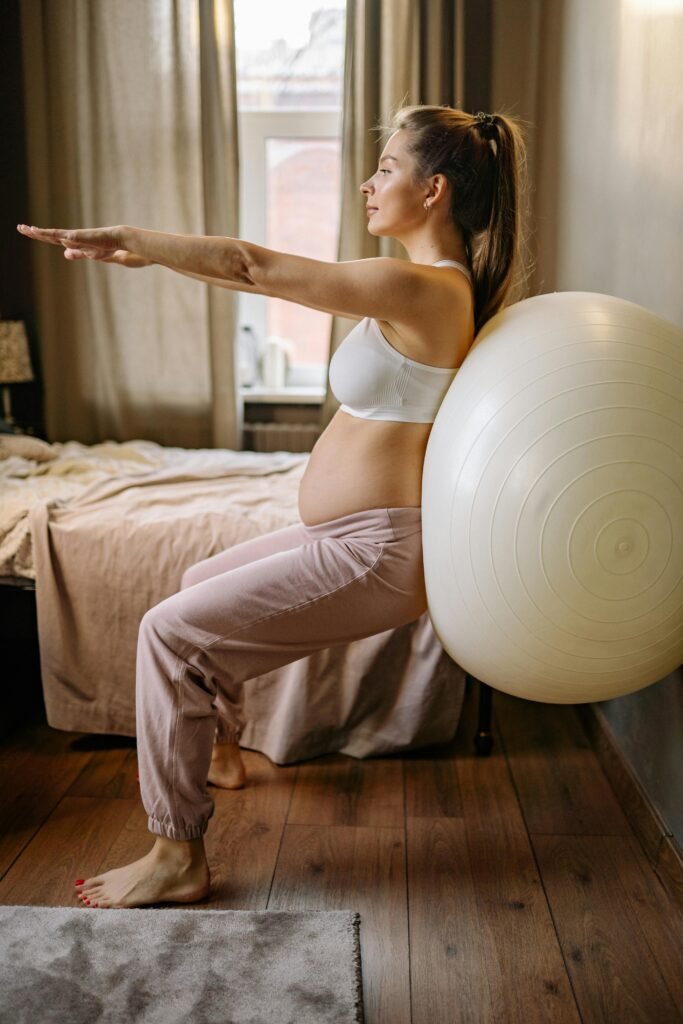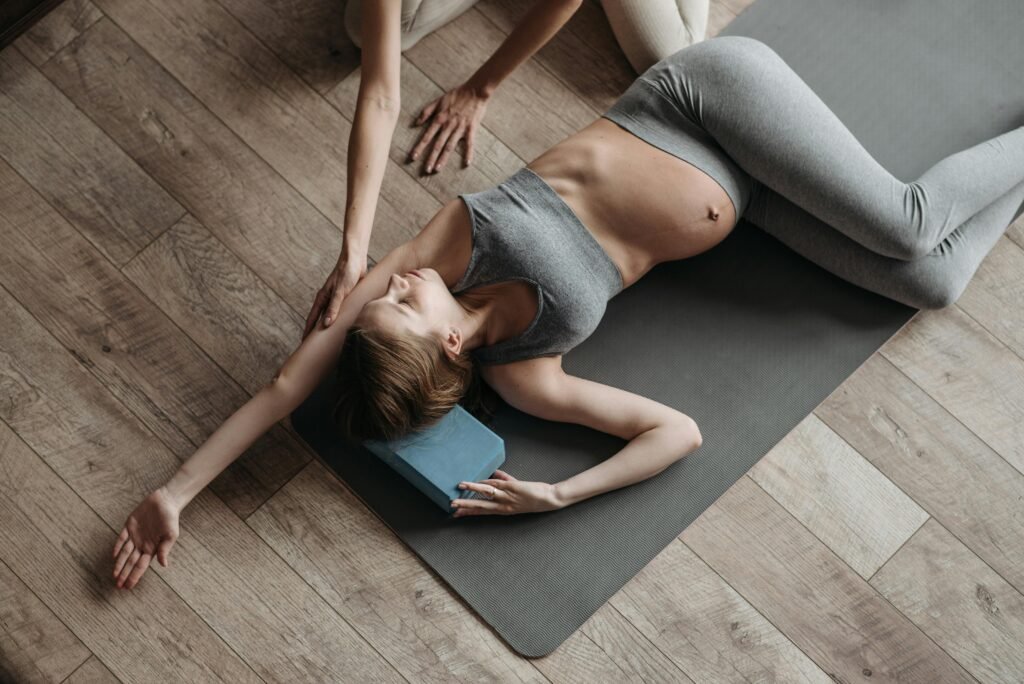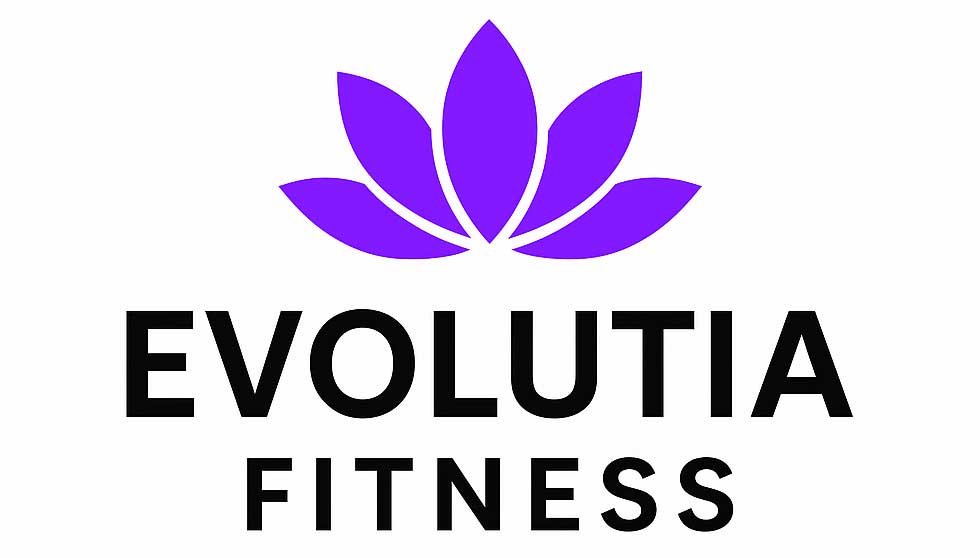Sciatica pain during pregnancy can feel like a relentless pinch, radiating from your lower back to your legs, but gentle yoga with props offers a soothing, safe solution. This article outlining Yoga Poses for Sciatica Pain in Pregnant Women helps expectant mothers to ease nerve pain through a 10-minute sequence designed for comfort and accessibility. These 4 poses are best for pregnant women, yoga enthusiasts, and prenatal educators seeking natural pain relief for conditions like sciatica, which affects up to 30% of pregnancies (Vleeming et al., 2008). These poses and routine blend accessibility, science, and community engagement to support a pain-free pregnancy.
💡 Curious about other pregnancy-safe yoga poses? See our piece on Yoga Poses for Pregnancy to get more ideas for safe yoga during pregnancy.
📌 Looking for more yoga routines? Check out our Yoga for Pain Relief Series for guides like Yoga for TMJ or Fibromyalgia.
What to Expect from This Routine
This routine creates a gentle, prop-supported yoga sequence to relieve sciatica pain in pregnant women, using bolsters, blocks, and blankets for safety and comfort. It’s beginner-friendly, research-backed, and ideal for r/pregnancy posts, prenatal classes, or at-home yoga.
What You’ll Learn:
- How to perform a 10-minute yoga sequence for sciatica relief during pregnancy.
- Safe use of props to support prenatal bodies and reduce nerve pain.
- Ways to share your journey and inspire others in wellness communities.

Why Do Yoga Poses for Sciatica Pain in Pregnant Women?
Sciatica, caused by compression of the sciatic nerve, often worsens during pregnancy due to weight gain and pelvic shifts, impacting 20–30% of expectant mothers (Vleeming et al., 2008). Yoga with props offers a low-impact way to stretch tight muscles, improve circulation, and reduce nerve irritation, with studies showing a 30% reduction in pain intensity after regular practice (Cramer et al., 2017). Unlike generic stretches or medical interventions, this prop-supported approach ensures safety for pregnant bodies, avoiding strain on the abdomen or joints. By sharing pain relief stories on r/pregnancy or iNaturalist-inspired wellness platforms, users can support prenatal health across online communities as well.
Fun fact: Yoga’s gentle stretches can reduce sciatica pain by improving pelvic alignment, a key factor in pregnancy discomfort (Cramer et al., 2017)!
What You’ll Need
- Yoga Bolster: Rectangular or round (~$20–40) for spinal support.
- Yoga Blocks: 2 foam or cork blocks (~$10–15) for elevation.
- Blankets: 2–3 soft, folded blankets for cushioning.
- Yoga Mat: Non-slip mat for stability.
- Optional: Chair for balance, strap for stretching, non-slip socks, journal for tracking pain relief.
Cost: ~$30–60, depending on sourced materials (e.g., household blankets, borrowed props).
Time: 1 hour to set up, plus 10 minutes per yoga session.
Directions
- Set Up the Space
- Choose a quiet, well-ventilated area with a flat surface; lay down a non-slip yoga mat to prevent slipping.
- Arrange props (bolster, blocks, blankets) within reach; ensure the space is warm (20–25°C) to relax muscles and avoid chills.
- Consult your healthcare provider before starting, especially if you have pregnancy complications like placenta previa (Ostgaard et al., 1994).
- Prepare the Routine
- Prepare your 10-minute routine with 4 prop-supported poses: Supported Pigeon, Reclined Twist, Supported Child’s Pose, and Legs-Up-the-Wall. Each pose targets hip, lower back, and gluteal muscles to relieve sciatic nerve pressure.
- Fold blankets to 2–3 inches thick for cushioning; place a block under your bolster for adjustable height.
- Practice diaphragmatic breathing (4-second inhale, 4-second exhale) to enhance relaxation and pain relief (Villemure et al., 2015).
- Perform the Poses
- Supported Pigeon (3 minutes): Sit on a folded blanket; place one ankle over the opposite thigh, keeping the pelvis neutral. Slide a block under the raised knee for support and lean forward slightly. Hold for 1.5 minutes per side to stretch piriformis muscles, a common sciatica trigger (Cramer et al., 2017).
- Reclined Twist (2 minutes): Lie on your side with a bolster under your knees; gently twist your upper body, resting your shoulder on a blanket. Hold for 1 minute per side to release lower back tension safely (Ostgaard et al., 1994).
- Supported Child’s Pose (3 minutes): Kneel with knees wide, place a bolster between thighs, and rest your chest on it, arms relaxed. Use blankets under knees for comfort. Hold to relax hips and spine.
- Legs-Up-the-Wall (2 minutes): Lie on your back with hips on a folded blanket; rest legs vertically on a wall, using a block for lumbar support. Hold to improve circulation and reduce nerve irritation.
- Monitor Progress and Iterate
- Practice the sequence 3–5 times weekly, ideally in the morning or evening when pain is less intense; stop if you feel discomfort or contractions.
- Track pain levels in a journal (e.g., 1–10 scale) to note progress; expect a 20–30% pain reduction after 2–4 weeks (Cramer et al., 2017).
- Modify poses with extra props (e.g., chair for balance) if mobility is limited in later trimesters (Ostgaard et al., 1994).
- Maintain and Connect
- Clean props monthly with mild soap to prevent dust or bacteria; store in a dry, shaded area to maintain quality.
- Share your pain relief journey on r/pregnancy or prenatal wellness forums with #PregnancyYogaSciatica to inspire others and support holistic health advocacy.

Tips to See the Best Success
- Use Props Generously: Stack blankets or blocks to customize support, ensuring no strain on your pelvis or abdomen (Villemure et al., 2015).
- Avoid Overstretching: Keep movements gentle to protect ligaments loosened by pregnancy hormones; avoid deep forward bends (Ostgaard et al., 1994).
- Practice Mindfulness: Pair poses with guided meditation (e.g., body scan) to reduce stress, a sciatica aggravator, boosting relief by 15% (Cramer et al., 2017).
- Engage Your Community: Share progress photos or tips on r/pregnancy with #PregnancyYogaSciatica to connect with other expectant mothers.
- Consult Experts: Work with a prenatal yoga instructor for personalized modifications, especially in the third trimester (Vleeming et al., 2008).
Benefits of Yoga Poses for Sciatica Pain in Pregnancy
- Pain Reduction: Reduces sciatica pain intensity by 20–30% with regular practice, per clinical studies (Cramer et al., 2017).
- Safe for Pregnancy: Prop-supported poses protect the abdomen and joints, unlike unsupported yoga or high-impact exercise (Ostgaard et al., 1994).
- Improved Mobility: Enhances hip and pelvic flexibility by 15%, easing daily movements like walking (Villemure et al., 2015).
- Stress Relief: Lowers cortisol levels, reducing pain perception by 10–15%, vital for prenatal health (Cramer et al., 2017).
Fun fact: Props like bolsters mimic the body’s natural curves, making yoga accessible even in late pregnancy (Villemure et al., 2015)!
Variations and Enhancements
- Seated Sequence: Adapt poses for a chair (e.g., seated pigeon) for women with limited floor mobility in late pregnancy.
- Partner Yoga: Include a partner to assist with prop placement or gentle massage, enhancing relaxation and bonding.
- Classroom Kit: Create a prenatal yoga guide with prop-based sequences for doulas or childbirth educators to use in classes.
- Digital Tracking: Use a wellness app (e.g., Prenatal Yoga) to log sessions and pain levels, sharing data with healthcare providers.
- Virtual Community: Host a Zoom prenatal yoga session focusing on sciatica relief, promoting #PregnancyYogaSciatica on social media.
FAQs About Doing Yoga Poses for Sciatica Pain While Pregnant
- Why use yoga poses for sciatica pain during pregnancy?
They reduce pain by 20–30% and improves mobility safely with props (Cramer et al., 2017).
- Is it safe for pregnant women?
Yes, with prop support and healthcare provider approval, avoiding strain (Ostgaard et al., 1994).
- What props are essential?
Bolsters, blocks, and blankets ensure comfort and safety (Villemure et al., 2015).
- How often should I practice?
3–5 times weekly, 10 minutes per session, for optimal relief (Cramer et al., 2017).
- Can it help in all pregnancy trimesters?
Yes, with modifications (e.g., chair support in third trimester) for safety (Vleeming et al., 2008).
